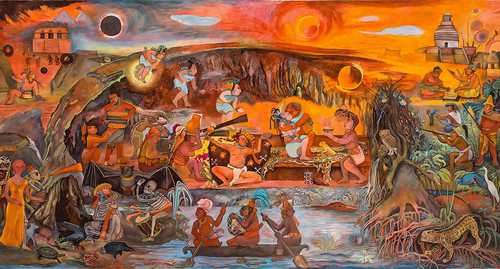The Museum of the Palace of Fine Arts announced that the mural painting will be added to its permanent collection Xibalba, the underworld of the Mayansby Rina Lazo, starting tomorrow. The Guatemalan artist will thus become the first woman to join the collection of 17 murals, spanning from 1928 to 1963.
In a statement, the institution reported that as part of the celebrations for the 90th anniversary of the venue, the work of Rina Lazo (Guatemala, October 23, 1923 – Mexico City, November 1, 2019) will be incorporated into the mural area on the second floor.
Originally from Cobán, Alta Verapaz, Guatemala, Lazo grew up immersed in the Maya-Quiché culture before adopting Mexico as her country of residence. Her interest in the pre-Columbian cultures of this territory significantly influenced her work as a muralist, painter and printmaker.
Lazo defined herself as a Mesoamerican artist
so for the museum his work not only enriches its collection with a unique vision of the Mayan worldview, but also contributes to the preservation and promotion of the cultural and artistic heritage of Mexico and Central America.
In Xibalba, the underworld of the Mayanshis latest mural creation, Lazo represents the mythology of the Mayan-Quiché people, inspired by the sacred book Popol Vuh. Unlike other cultures that consider the underworld as a punishment, the Mayans saw it as a natural phase of the life cycle.
Light, joy and celebration
The mural reflects a bright, joyful and festive atmosphere, in addition to synthesizing key elements of Mayan culture and worldview, such as the transit of the Sun and the birth of corn from the underworld, fundamental elements of the myth of Xibalbá.
It also refers to the twin heroes Hunahpú and Ixbalanqué, who descended to the underworld deceived by the gods Hun Camé and Vucub Camé.
This painting, measuring more than 2 meters high and 5 meters wide, was shown to the public for the first time, three years after Lazo’s death, at the International Hall of the Palacio de Bellas Artes, from April 27 to July 24, 2022, as a tribute to the artist’s creativity, determination and talent, while recognizing her convictions and desires for social justice and the contribution of women to the muralist movement.
Later, as part of Lazo’s centenary, the mural was presented at the El Palacio Centro Cultural Museum, located in the capital of the state of Campeche, from December 15, 2023 to July 28, 2024.
Finally, the work will be available to the public on a permanent basis at Mexico’s largest arts venue starting tomorrow.
Rina Lazo Wasem arrived in our country in 1946 thanks to a scholarship from the Guatemalan government to continue her studies in the arts.
The following year, he collaborated with Diego Rivera at the National School of Painting, Sculpture and Engraving La Esmeralda.
In 1965, Lazo won a competition held by the National Institute of Anthropology and History to make a facsimile reproduction of the Bonampak murals, which were exhibited in the then recently inaugurated National Museum of Anthropology.
